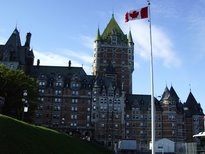 Notre Dame and the bust of King Louis XIV. Photo copyright: DAVID McMAHON
Notre Dame and the bust of King Louis XIV. Photo copyright: DAVID McMAHONIT'S like a scene from The King And I. There's Louis XIV and I, side by side. It's mid afternoon in Quebec City, Canada, and his highness and I are completely drenched.
There's much to learn about the reign (or rain, as it may be) of the French monarch. His statue, in the centre of the square outside Notre-Dame-des-Victoires, is adorned with quivering, translucent raindrops that glisten and shimmer like misplaced pearls.
The ruler, who assumed France's throne in 1661, played a pivotal role in settling disputes between Catholic priests and missionaries, and the fur traders, who wielded great influence in the new colony.
If you want proof that religion played a strong hand in the province's early history, drive about half an hour out of the city, to the stunning Basilica of St Anne de Beaupre.
The statue of St Anne the mother of the Virgin Mary and grandmother of Jesus is known as the statue of miracles. Despite the constant stream of pilgrims, there is an enveloping silence inside the magnificent domed structure.
At the entrance are crutches and other medical equipment, left behind by those who came and found a miraculous cure.
Religion is not the only factor that fortifies Quebecois. Their city is the only fortified metropolis in North America whose walls are still standing. Even those with little passion for history's rich tapestry would have a tingling spine at several reminders of the city's former status as a prime outpost.
 The pre-dawn sky is silver-grey as I walk through the imposing Porte St-Louis gate. The Parliament complex is behind my right shoulder, the Plains of Abraham are on my left.
The pre-dawn sky is silver-grey as I walk through the imposing Porte St-Louis gate. The Parliament complex is behind my right shoulder, the Plains of Abraham are on my left.The silence is so all-enveloping I can hear my footsteps echoing as I climb the slope to the fortifications. As in everything else in life, it is indeed the fort that counts.
The hillside is emerald green, the trees still dripping rain as the Lower City is spread out before me, a melting pot of amazing rooflines and stately architecture.
The St Lawrence River is a wide grey ribbon that stretches to the horizon as the brooding cloud closes in again.
Momentarily, I am disappointed that the brilliant sunrise I hoped for will not happen. Instead, the photographs I take in the steady rain show the city skyline in a unique manner, like a soft-focus oil painting.
 Spread out like a 3D street directory are an assortment of roof styles and colours. Towering above all else is the magnificent Chateau Frontenac, virtually the city's cultural symbol.
Spread out like a 3D street directory are an assortment of roof styles and colours. Towering above all else is the magnificent Chateau Frontenac, virtually the city's cultural symbol.A stone's throw away from its imposing shadow is the wide sweep of the Dufferin Terrace. Central to the scene, as if looking over the city and waterfront, is the statue of Samuel de Champlain.
He established a fur-trading post in 1608, ensuring that Quebec City would be a cultural prize that would change hands many times during the 17th and 18th centuries.
Perhaps it is Champlain himself who rolls back the clouds, unveiling the Chateau Frontenac for me to photograph under a brilliant blue sky.
I travelled courtesy of the Canadian Tourism Commission and Air Canada.


